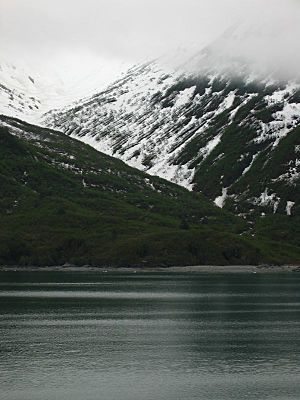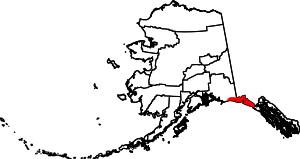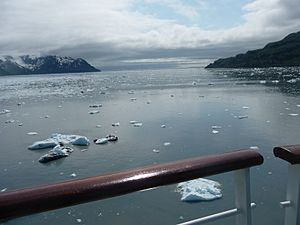Yakutat, Alaska facts for kids
Quick facts for kids
City and Borough of Yakutat
Yaakwdáat
|
|
|---|---|
|
Home Rule Borough
|
|

Yakutat Bay
|
|

Map of Alaska highlighting Yakutat City and Borough
|
|
| Country | United States |
| State | Alaska |
| Borough seat | Yakutat |
| Area | |
| • Borough | 103.73 sq mi (268.66 km2) |
| • Land | 100.37 sq mi (259.96 km2) |
| • Water | 3.36 sq mi (8.70 km2) |
| • Urban
(CDP)
|
104.1 sq mi (269.6 km2) |
| • Land (CDP) | 100.5 sq mi (260.3 km2) |
| • Water (CDP) | 3.6 sq mi (9.3 km2) |
| Elevation | 69 ft (21 m) |
| Population
(2020)
|
|
| • Borough | 662 |
| • Density | 6.6/sq mi (2.53/km2) |
| • Urban
(CDP)
|
657 |
| • Urban density | 6.311/sq mi (2.4369/km2) |
| Time zone | UTC−9 (Alaska (AKST)) |
| ZIP code |
99689
|
| FIPS code | 02-282 (borough), 02-86490 (CDP) |
| GNIS feature ID | 1415858, 1419986 |
The City and Borough of Yakutat ( YAK-ə-tat; Tlingit: Yaakwdáat; Russian: Якутат) is a borough in the U.S. state of Alaska and the name of a former city within it. The name in Tlingit is Yaakwdáat (meaning "the place where canoes rest"). It derives from an Eyak name, diyaʼqudaʼt, and was influenced by the Tlingit word yaakw ("canoe, boat").
The borough covers an area about six times the size of the U.S. state of Rhode Island, making it one of the largest counties (or county equivalents) in the United States. As of the 2020 census, the population was 662, same number as previous census. As of 2010, it was Alaska's least populous borough or census area, and the ninth-least populous county nationwide. The population had declined from 680 in 2000.
The Borough of Yakutat was incorporated as a non-unified Home Rule Borough on September 22, 1992. Yakutat was previously a city in the Skagway–Yakutat–Angoon Census Area (afterwards renamed as the Skagway–Hoonah–Angoon Census Area).
The U.S. Census Bureau has defined the former City of Yakutat as a census-designated place within the borough. The only other significant population center in the borough is the community of Icy Bay, the site of the Icy Bay Airport, in the west-central part of the borough.
History
The original settlers in the Yakutat area are believed to have been Eyak-speaking people from the Copper River area. Tlingits migrated into the area and assimilated the Eyaks before the arrival of Europeans in Alaska. Yakutat was only one of a number of Tlingit and mixed Tlingit-Eyak settlements in the region, although all the others have been depopulated or abandoned.
In the eighteenth and nineteenth centuries, English, French, Spanish and Russian explorers came to the region. The Shelikhov-Golikov company, precursor of the Russian-American Company, built a fort in Yakutat in 1795 to facilitate trade in sea otter pelts. It was known as New Russia, Yakutat Colony, or Slavorossiya. When the Russians cut off access to the fisheries nearby, a Tlingit war party attacked and destroyed the fort.
By 1886, after the Alaska Purchase by the United States, the black sand beaches in the area were being mined for gold. In 1889 the Swedish Free Mission Church opened a school and sawmill in the area. A cannery, another sawmill, a store and a railroad were constructed from 1903 by the Stimson Lumber Company. Many people moved to the current site of Yakutat to be closer to the Stimson cannery, which operated through 1970. During World War II, the USAAF stationed a large aviation garrison near Yakutat and built a paved runway. The troops were withdrawn after the war but the runway is still in use as Yakutat Airport, which offers scheduled airline service.
Fishing is currently the largest economic activity in Yakutat.
Yakutat Tlingit Tribe (YTT) received a Language Preservation Grant from the Administration for Native Americans in 2004. With this, they have reinvigorated their efforts to teach the Tlingit language to middle-aged and young people. YTT received another ANA grant in 2007 and is expanding its role in the schools. All the YTT Tlingit language revitalization work focuses on using communicative approaches to second language teaching, such as TPR and ASLA.
While working at a local cannery from 1912 to 1941, Seiki Kayamori extensively photographed Yakutat and its area. A large set of prints of his work is held by Yakutat City Hall.
Geography
According to the U.S. Census Bureau, the borough has a total area of 9,463 square miles (24,510 km2), of which 7,649 square miles (19,810 km2) is land and 1,813 square miles (4,700 km2) is water. The 2010 census also defines a smaller census-designated place named Yakutat which hasa total area of 104.1 square miles (269.6 km2), of which 100.5 square miles (260.3 km2) is land and 3.6 square miles (9.3 km2) is water.
Yakutat's population center is located at 59°32′49″N 139°43′38″W / 59.54694°N 139.72722°W, at the mouth of Yakutat Bay. It lies in an isolated location in lowlands along the Gulf of Alaska, 212 mi (341 km)) northwest of Juneau.
Yakutat borders the Gulf of Alaska to the west, Valdez-Cordova Census Area, Alaska to the northwest, Hoonah-Angoon Census Area, Alaska to the southeast, Stikine Region, British Columbia to the northeast-east and Yukon Territory to the north.
The borough contains part of the protected areas of Chugach National Forest, Glacier Bay National Park, Glacier Bay Wilderness, Tongass National Forest, Wrangell-St. Elias National Park and Preserve, Wrangell-Saint Elias Wilderness and the Russell Fjord Wilderness.
One unique feature in the Borough is Hubbard Glacier, North America's largest tide-water glacier. In 1986 and 2002, the glacier blocked the entrance to Russell Fiord. The resulting Russell Lake rose 83 and 61 feet, until the glacial dam failed. If Russell Lake rises to 135 feet, the water will spill over a pass and flow into the Situk River. This will have a major impact on a world class fishery. Yakutat will not be impacted unless the glacier advances to the townsite, which could take a thousand years. The vegetation in the area indicates that water was flowing over the pass until about 1860.
Climate
Yakutat has a climate located on the boundary of the subarctic (Dfc) and subpolar oceanic (Cfc) regimes. Yakutat has the typical high precipitation, absence of frozen soil and temperate rainforest vegetation of the subpolar oceanic climate zone of the Pacific Coast. It rivals Ketchikan as the wettest “city” in the United States, with an annual precipitation (1981−2010 normals) of 155 inches (3.94 m), which falls on 240 days of the year, including 150 inches (381 cm) of snow, almost all of it falling from November through April, that occurs on 64 days annually. (However, with an annual precipitation of 197.8 inches (5.02 m), the city of Whittier receives significantly more annual precipitation than both Yakutat and Ketchikan, which makes it the wettest city in Alaska and the United States, and Yakutat and Ketchikan the second and third wettest cities in Alaska respectively.) September and October represent, on average, the year's primary "rainy season," with an average of over 20 inches of precipitation both months. On average, the year's driest period is late April through July, though no month qualifies as a true "dry season." The monthly daily average temperature ranges from 28.1 °F (−2.2 °C) in January to 54.4 °F (12.4 °C) in July. Extreme temperatures have ranged from −24 °F (−31 °C) on December 30, 1964 up to 88 °F (31 °C) on August 15, 2004, though there are typically 4.9 days of sub-0 °F (−18 °C) lows and only 4 days of 70 °F (21 °C)+ highs annually. Unlike in South Central Alaska, a day with a subzero (°F) high has never been recorded.
| Climate data for Yakutat, Alaska (Yakutat State Airport), 1981−2010 normals | |||||||||||||
|---|---|---|---|---|---|---|---|---|---|---|---|---|---|
| Month | Jan | Feb | Mar | Apr | May | Jun | Jul | Aug | Sep | Oct | Nov | Dec | Year |
| Record high °F (°C) | 58 (14) |
56 (13) |
59 (15) |
71 (22) |
80 (27) |
87 (31) |
85 (29) |
88 (31) |
77 (25) |
63 (17) |
59 (15) |
52 (11) |
88 (31) |
| Average high °F (°C) | 33.7 (0.9) |
36.3 (2.4) |
39.5 (4.2) |
45.7 (7.6) |
52.3 (11.3) |
57.3 (14.1) |
60.1 (15.6) |
60.6 (15.9) |
55.7 (13.2) |
47.4 (8.6) |
38.5 (3.6) |
35.1 (1.7) |
46.9 (8.3) |
| Daily mean °F (°C) | 28.1 (−2.2) |
29.7 (−1.3) |
32.0 (0.0) |
37.8 (3.2) |
44.7 (7.1) |
50.8 (10.4) |
54.3 (12.4) |
53.8 (12.1) |
48.4 (9.1) |
41.0 (5.0) |
32.3 (0.2) |
29.6 (−1.3) |
40.2 (4.6) |
| Average low °F (°C) | 22.4 (−5.3) |
23.0 (−5.0) |
24.6 (−4.1) |
30.0 (−1.1) |
37.2 (2.9) |
44.4 (6.9) |
48.7 (9.3) |
47.3 (8.5) |
41.4 (5.2) |
34.8 (1.6) |
26.3 (−3.2) |
24.4 (−4.2) |
33.7 (0.9) |
| Record low °F (°C) | −22 (−30) |
−20 (−29) |
−20 (−29) |
3 (−16) |
9 (−13) |
29 (−2) |
35 (2) |
29 (−2) |
16 (−9) |
6 (−14) |
−10 (−23) |
−24 (−31) |
−24 (−31) |
| Average precipitation inches (mm) | 13.66 (347) |
10.86 (276) |
10.98 (279) |
9.19 (233) |
8.21 (209) |
6.39 (162) |
7.88 (200) |
14.15 (359) |
21.11 (536) |
22.01 (559) |
14.46 (367) |
16.28 (414) |
155.18 (3,941) |
| Average snowfall inches (cm) | 31.3 (80) |
28.2 (72) |
28.5 (72) |
11.0 (28) |
0.5 (1.3) |
0 (0) |
0 (0) |
0 (0) |
0 (0) |
3.2 (8.1) |
20.4 (52) |
27.4 (70) |
150.4 (382) |
| Average precipitation days (≥ 0.01 inch) | 21.9 | 18.6 | 19.3 | 18.5 | 17.5 | 17.0 | 18.5 | 18.9 | 21.7 | 24.0 | 21.6 | 22.5 | 240 |
| Average snowy days (≥ 0.1 in) | 12.0 | 11.0 | 11.6 | 6.1 | 0.3 | 0 | 0 | 0 | 0 | 1.7 | 8.7 | 12.6 | 64 |
| Source: NOAA (extremes 1917−present) | |||||||||||||
Demographics
| Historical population | |||
|---|---|---|---|
| Census | Pop. | %± | |
| 1880 | 300 | — | |
| 1890 | 308 | 2.7% | |
| 1900 | 247 | −19.8% | |
| 1910 | 271 | 9.7% | |
| 1920 | 165 | −39.1% | |
| 1930 | 265 | 60.6% | |
| 1940 | 292 | 10.2% | |
| 1950 | 298 | 2.1% | |
| 1960 | 230 | −22.8% | |
| 1970 | 190 | −17.4% | |
| 1980 | 449 | 136.3% | |
| 1990 | 534 | 18.9% | |
| 2000 | 680 | 27.3% | |
| 2010 | 662 | −2.6% | |
| 2020 | 662 | 0.0% | |
| U.S. Decennial Census 1990-2000 2010-2018 |
|||
Yakutat first appeared on the 1880 U.S. Census as an unincorporated Tlingit-Yakutat village. All 300 residents were listed as Tlingit. In 1890, it reported 308 residents, and this included the populations of the native villages at Dry Bay & Lituya (Bay). 300 were listed as Native, 7 Whites and 1 Creole (Mixed Russian & Native). It continued to report on every successive census. In 1948, Yakutat formally incorporated. In 1992, it broke away from the Skagway-Yakutat-Angoon Census Area to form its own borough of Yakutat. It disincorporated at its formation and became a census-designated place (CDP).
2010 Census
At the 2010 census, there were 662 people, 502 households, and 201 families residing in the Yakutat. The racial makeup was 50.37% White, 0.12% Black or African American, 39.60% Native American, 1.24% Asian, 0.74% Pacific Islander, and 7.92% from two or more races. Hispanic or Latino of any race were 0.74% of the population.
5.78% reported speaking Tlingit at home.
Of the 265 households, 32.8% had children under the age of 18 living with them, 38.5% were married couples living together, 12.1% had a female householder with no husband present, and 40.0% were non-families. 32.1% of households were one person, and 4.9% were one person aged 65 or older. The average household size was 2.59 and the average family size was 3.30.
The population was spread out, with 28.1% under the age of 18, 5.3% from 18 to 24, 32.5% from 25 to 44, 28.7% from 45 to 64, and 5.3% 65 or older. The median age was 37 years. For every 100 females, there were 145.6 males. For every 100 females age 18 and over, there were 161.7 males.
The median household income was in Yakutat was $46,786, and the median family income was $51,875. Males had a median income of $41,635 versus $25,938 for females. The per capita income was $22,579. About 11.8% of families and 13.5% of the population were below the poverty line, including 22.5% of those under age 18 and 8.3% of those age 65 or over.
Images for kids
See also
 In Spanish: Yakutat (Alaska) para niños
In Spanish: Yakutat (Alaska) para niños



